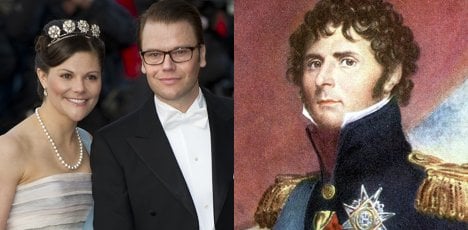It is nearly impossible to escape the fact that there will be a royal wedding in Sweden this year. The marriage of Crown Princess Victoria to Daniel Westling is in the news almost daily and pictures of the happy couple beam down from billboards at passengers arriving at Arlanda Airport.
What has not been so widely discussed is that this royal wedding coincides with the 200th anniversary of the election of Jean Baptiste Bernadotte as Sweden’s Crown Prince. One can only speculate over whether the timing of the wedding is merely coincidence or careful and thoughtful planning to help commemorate the foundation of the current Bernadotte dynasty.
So how did it come to be that an ambitious middle aged man from southern France was able to be proclaimed Crown Prince of Sweden? Ironically, it was thanks to the revolution in France, and the overthrow of their monarchy, that the Bernadottes became Sweden’s royal family.
By the first decade of the 19th century the face of Europe had been scarred by war and revolution. Borders and territories had shifted and in what seemed like a strategic game of chess the Emperor Napoleon played his pieces by installing his own family members on many of Europe’s thrones. At the same time the once mighty war machine of Sweden was but a faded memory. Sweden’s King Karl XIII’s two children had died in infancy and his adopted son, and successor, Prince Karl August also died suddenly. The country was in political turmoil and without an heir.
In a feat that would have been impossible before the French revolution and the fall of the Bourbon monarchs, the non-aristocratic Bernadotte rose in the ranks of the French military to become an officer. His military expertise brought him to the attention of Napoleon who eventually made Bernadotte a Marshal of France. This was one of the highest honors of the time.
There is however a parallel storyline to the life of Jean Baptiste Bernadotte which may also explain his rise in the ranks. In 1798 Bernadotte married Désirée Clary, the daughter of a wealthy silk merchant from Marseille. She also happened to be the first love of Napoleon. Despite Napoleon’s love for the young Désirée their relationship came to an abrupt end when he married the widow Joséphine de Beauharnais.
Being a man of strategy Napoleon knew that a woman of society, such as the aristocratic Joséphine, would help him to realise his ambitions. Napoleon however always kept an eye on Désirée, even after her marriage to Bernadotte. This was simplified by the fact that his own brother Joseph Bonaparte married Désirée’s sister Julie.
No matter which way you look at it, Bernadotte became a well regarded man during the French Republic and later Empire. His reputation spread all the way to Sweden where a dynastic crisis was occurring. There is a lot of speculation on how the name of Jean Baptiste Bernadotte ever made it into the running, but most historians agree that it was in fact a lone Swedish nobleman who encouraged Bernadotte to contend for the position of Crown Prince.
The choice was not immediately popular, and the nobleman was actually imprisoned for a short time because of his tactlessness in suggesting the position to a mere French marshal. In time, Bernadotte became more accepted and in 1810 he was proclaimed Crown Prince by the Swedish Parliament meeting in Örebro. A few months later the country’s heir apparent arrived in his new home. Eight years later Bernadotte became King Karl XIV Johan of Sweden and Norway.
The acceptance of Bernadotte as the new ruler of Sweden by Europe’s other monarchs was not instantaneous. The new Swedish monarch was not of royal birth, and the turmoil the now exiled Napoleon had thrown the continent into was not forgiven. Napoleon did not install Bernadotte on the Swedish throne, but their names were still closely associated. It was through a marriage that Europe’s royal families finally would acknowledge their new cousins in the North.
In 1823 the son of King Karl XIV Johan and Queen Désirée, Crown Prince Oscar, married Joséphine of Leuchtenberg. The German Princely House of Leuchtenberg helped bring legitimacy to the House of Bernadotte. The affiliation to the Napoleonic Dynasty was however never completely severed. Joséphine of Leuchtenberg also happened to be the grand-daughter of Napoleons former wife, the ex-Empress Joséphine. Needless to say Désirée kept a close eye on her daughter-in-law.
Today the Bernadotte Dynasty is closely intertwined with Europe’s other ruling houses through a series of dynastic marriages. Amongst other notable ancestors, Sweden’s future Queen can claim Britain’s Queen Victoria. After two hundred years the royal legitimacy of the Bernadottes is no longer an issue.
Besides the Royal Wedding the Bernadotte bicentenary will also be commemorated in the late summer and autumn. On August 21 the Royal Family will visit Örebro to commemorate the election of Jean Baptiste Bernadotte as Sweden’s Crown Prince. On October 20 the Royal Family will visit the port city of Helsingborg – where Bernadotte first stepped onto Swedish soil.
Juan Navas, a journalist and former information secretary at the Royal Court, will be writing a series of articles about Swedish royalty in the run up to the royal wedding on June 19th. From next week he will also be writing a royal wedding blog.



 Please whitelist us to continue reading.
Please whitelist us to continue reading.
Member comments